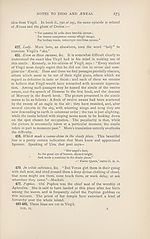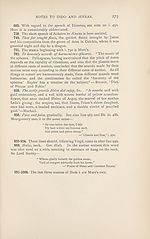Scottish Text Society publications > Old series > Works of Sir William Mure of Rowallan > Volume 2, 1898
(286)
Download files
Complete book:
Individual page:
Thumbnail gallery: Grid view | List view

274
NOTES TO DIDO AND yENEAS.
493, &c. This description of “natur’s alchimists” is an extension
of that in Virgil, who makes no mention of the bees bearing “ litle
stones” as “ballast” to “contrepoyze the winde.” He also speaks
simply of driving away the drones, not of killing them.
524-527. These lines are original.
547. The woodden horse. Not in Virgil. From this to line 558
Mure gives us a brief paraphrase of the lines in the ‘.dSneid.’
563. There Memnon, there the souldiers of Anrore. Memnon was
son of Tithonus and Eos or Aurora. He was king of the Ethiopians,
and came to the assistance of Priam towards the end of the Trojan
war. He was slain by Achilles after a long and fierce combat.
Virgil’s line is—
“ Eoasque acies, et nigri Memnonis arma,”
which Mackail translates, “ The eastern ranks and smart Memnon’s
armour.”
565. Penthesilea, Queen of the Amazons. In the Trojan war she
assisted the Trojans, and fought gallantly against the Greeks. She
fell by the hand of Achilles, who, as she was dying, mourned over her
on account of her youth, beauty, and valour.
569, 570. Original, as are also lines 583-592.
595. Iris, the personification of the rainbow.
599-630. These lines, and also 633-642, are by Mure.
600. Lame Vulcan's wife, Aphrodite or Venus. The contest among
the three goddesses as to which was most beautiful was decided by
Paris, who gave judgment in favour of Venus.
618. Enchaunting Circe, practising enchantments. When Odys¬
seus came to the island of Aiaea where Circe dwelt, she changed some
of his companions to pigs, but became so attached to Odysseus him¬
self that she induced him to stay a year with her.
633-654. By Mure, with exception of lines 637 and 643.
674. Thetis, a marine divinity. Like her sisters the Nereids, she
dwelt in the depths of the sea with her father Nereus. She was the
mother of Achilles.
677. Chymeraees vaine. The chimaera was a monster the fore part
of whose body was that of a lion, the hind part that of a dragon, and
the middle part that of a goat. She had three heads corresponding
to those three animals, and, breathing out fire, caused great havoc
among men and beasts. Virgil places her, together with other mon¬
sters, at the entrance to Orcus :—
“ Multaque prseterea variarum monstra ferarum,
Centauri in foribus stabulant, Scyllasque biformes,
Et centum geminus Briareus, ac bellua Lernte
Horrendum stridens, flammisque armata Chimaera :
Gorgones, Harpyioeque et forma tricorporis umbrae.”
—‘ Aineid,’ vi. 1. 285.
NOTES TO DIDO AND yENEAS.
493, &c. This description of “natur’s alchimists” is an extension
of that in Virgil, who makes no mention of the bees bearing “ litle
stones” as “ballast” to “contrepoyze the winde.” He also speaks
simply of driving away the drones, not of killing them.
524-527. These lines are original.
547. The woodden horse. Not in Virgil. From this to line 558
Mure gives us a brief paraphrase of the lines in the ‘.dSneid.’
563. There Memnon, there the souldiers of Anrore. Memnon was
son of Tithonus and Eos or Aurora. He was king of the Ethiopians,
and came to the assistance of Priam towards the end of the Trojan
war. He was slain by Achilles after a long and fierce combat.
Virgil’s line is—
“ Eoasque acies, et nigri Memnonis arma,”
which Mackail translates, “ The eastern ranks and smart Memnon’s
armour.”
565. Penthesilea, Queen of the Amazons. In the Trojan war she
assisted the Trojans, and fought gallantly against the Greeks. She
fell by the hand of Achilles, who, as she was dying, mourned over her
on account of her youth, beauty, and valour.
569, 570. Original, as are also lines 583-592.
595. Iris, the personification of the rainbow.
599-630. These lines, and also 633-642, are by Mure.
600. Lame Vulcan's wife, Aphrodite or Venus. The contest among
the three goddesses as to which was most beautiful was decided by
Paris, who gave judgment in favour of Venus.
618. Enchaunting Circe, practising enchantments. When Odys¬
seus came to the island of Aiaea where Circe dwelt, she changed some
of his companions to pigs, but became so attached to Odysseus him¬
self that she induced him to stay a year with her.
633-654. By Mure, with exception of lines 637 and 643.
674. Thetis, a marine divinity. Like her sisters the Nereids, she
dwelt in the depths of the sea with her father Nereus. She was the
mother of Achilles.
677. Chymeraees vaine. The chimaera was a monster the fore part
of whose body was that of a lion, the hind part that of a dragon, and
the middle part that of a goat. She had three heads corresponding
to those three animals, and, breathing out fire, caused great havoc
among men and beasts. Virgil places her, together with other mon¬
sters, at the entrance to Orcus :—
“ Multaque prseterea variarum monstra ferarum,
Centauri in foribus stabulant, Scyllasque biformes,
Et centum geminus Briareus, ac bellua Lernte
Horrendum stridens, flammisque armata Chimaera :
Gorgones, Harpyioeque et forma tricorporis umbrae.”
—‘ Aineid,’ vi. 1. 285.
Set display mode to: Large image | Zoom image | Transcription
Images and transcriptions on this page, including medium image downloads, may be used under the Creative Commons Attribution 4.0 International Licence unless otherwise stated. ![]()
| Publications by Scottish clubs > Scottish Text Society publications > Old series > Works of Sir William Mure of Rowallan > Volume 2, 1898 > (286) |
|---|
| Permanent URL | https://digital.nls.uk/107361992 |
|---|
| Attribution and copyright: |
|
|---|
| Description | A collection of over 100 Scottish texts dating from around 1400 to 1700. Most titles are in Scots, and include editions of poetry, drama, and prose by major Scottish writers such as John Barbour, William Dunbar, Gavin Douglas, and George Buchanan. Edited by a key scholarly publisher of Scotland's literary history, and published from the late 19th century onwards by the Scottish Text Society. Available here are STS series 1-3. |
|---|

